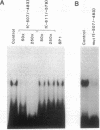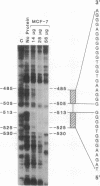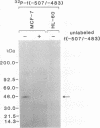Abstract
The present studies have examined the sequences responsible for regulating transcription of the human DF3 breast carcinoma-associated antigen (MUC1) gene. A region 1656 base pairs upstream to the DF3 transcription initiation site was fused to the chloramphenicol acetyltransferase gene. Transient expression assays using a series of deleted constructs demonstrated that the region from position -618 contains the regulatory sequences necessary for DF3 transcription in human MCF-7 breast cancer cells. Further analysis with internal deletion vectors and heterologous promoter constructs indicated the involvement of cis-acting elements in the fragment extending from positions -598 to -485. By gel retardation and DNA footprinting, we have identified a protein in MCF-7 cells that recognizes sequences between positions -505 and -485. The results of Southwestern studies demonstrate that this protein has an apparent molecular mass of 45 kDa. Taken together, these results suggest that DF3 gene transcription is regulated by a previously undescribed transacting factor.
Full text
PDF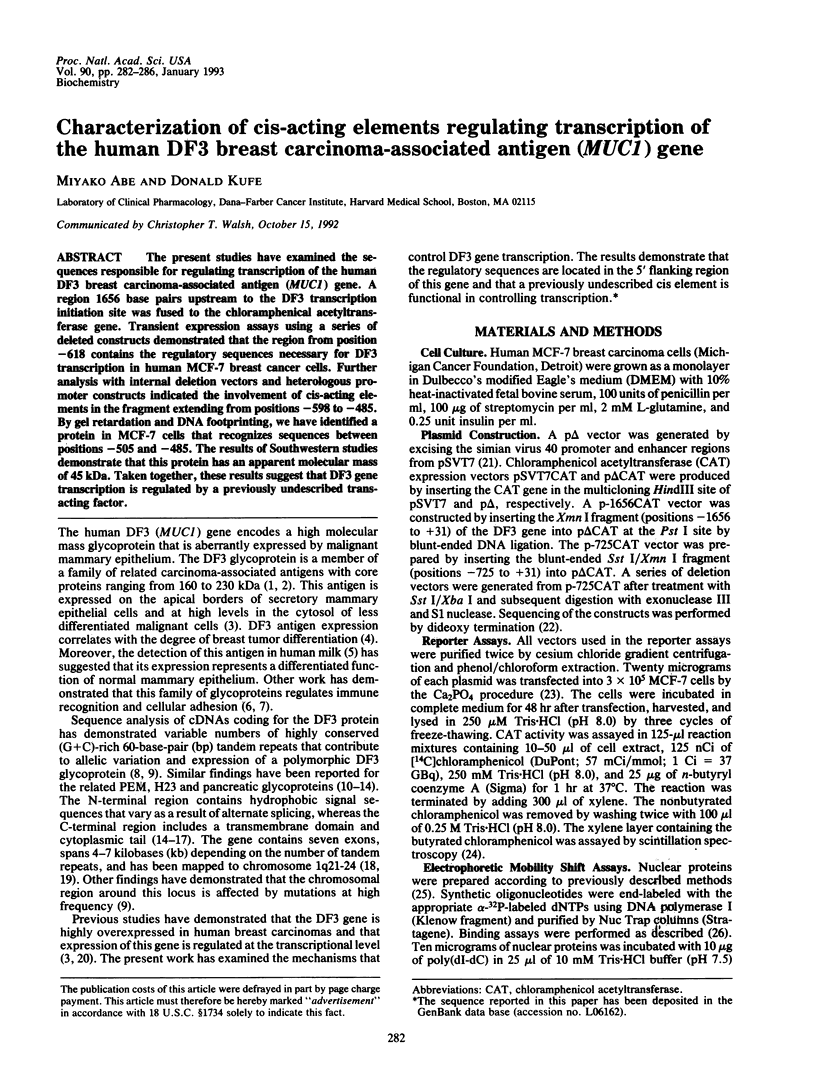
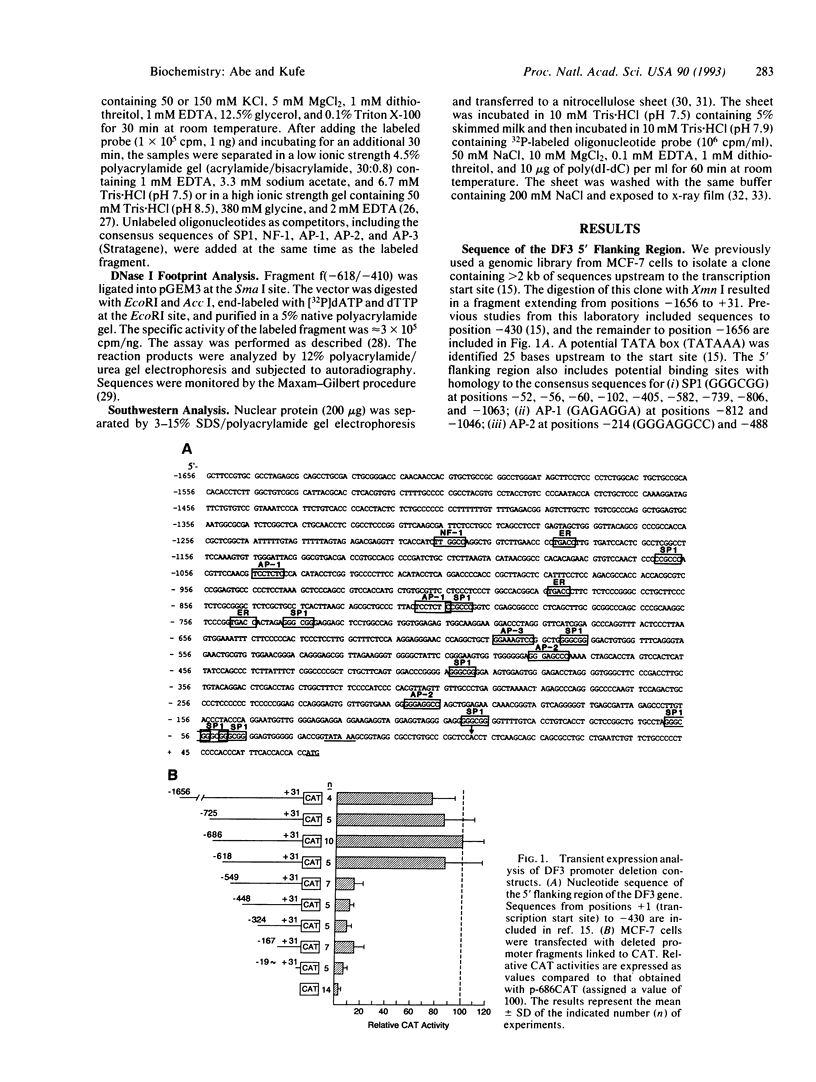
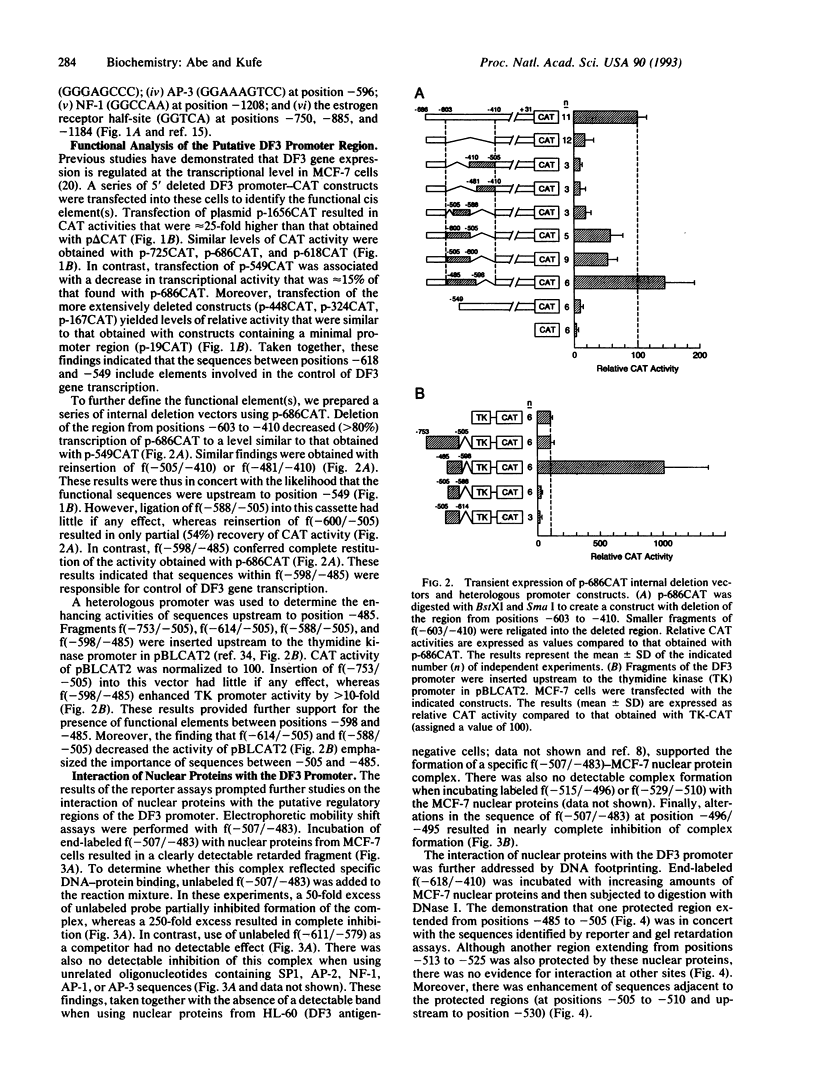
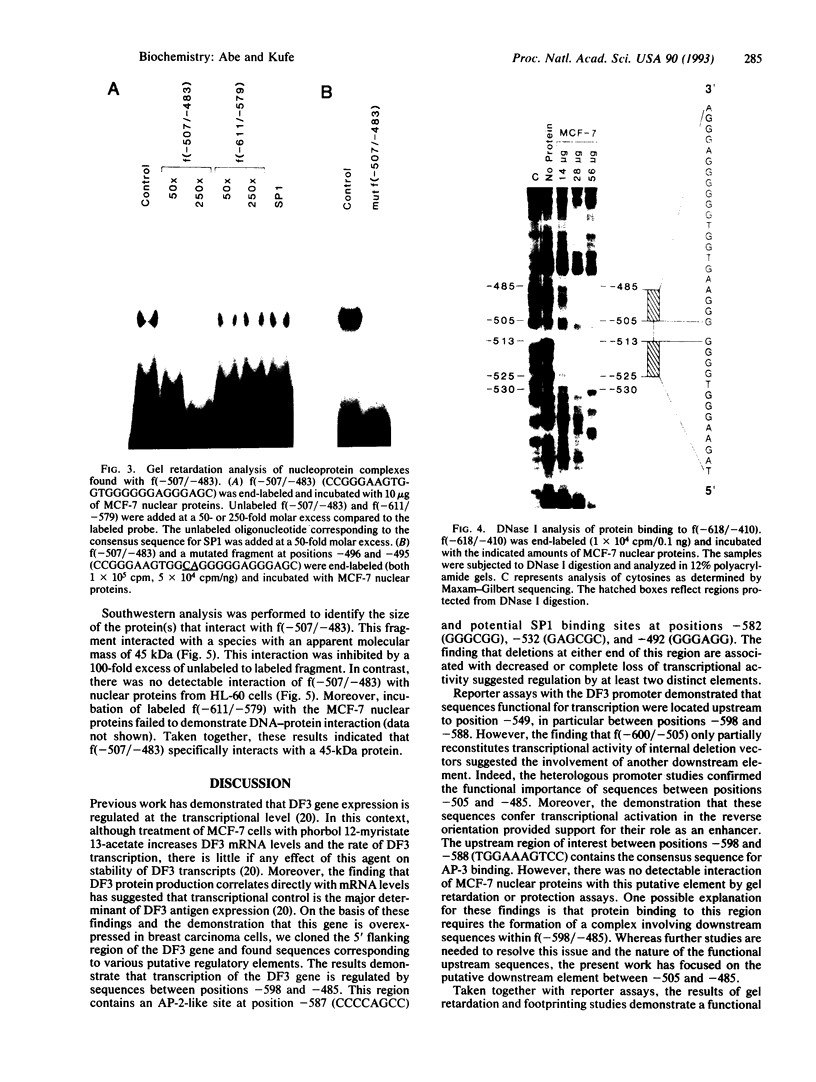
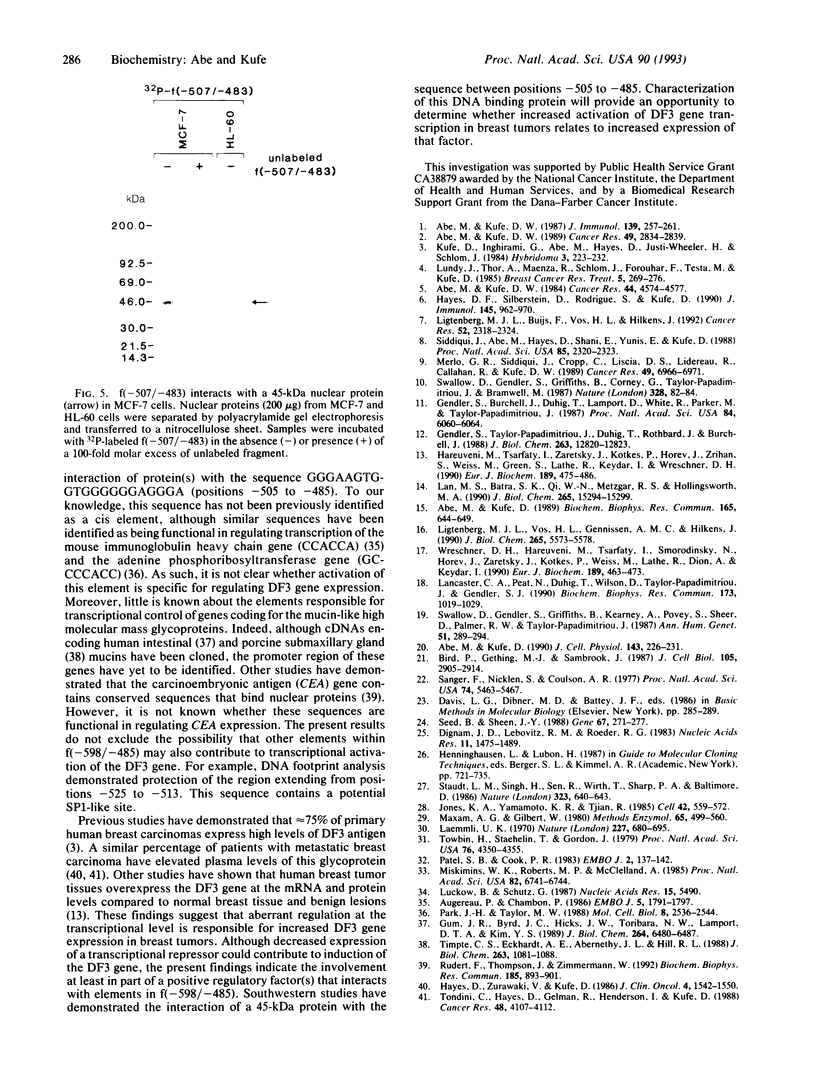
Images in this article
Selected References
These references are in PubMed. This may not be the complete list of references from this article.
- Abe M., Kufe D. W. Identification of a family of high molecular weight tumor-associated glycoproteins. J Immunol. 1987 Jul 1;139(1):257–261. [PubMed] [Google Scholar]
- Abe M., Kufe D. W. Sodium butyrate induction of milk-related antigens in human MCF-7 breast carcinoma cells. Cancer Res. 1984 Oct;44(10):4574–4577. [PubMed] [Google Scholar]
- Abe M., Kufe D. Structural analysis of the DF3 human breast carcinoma-associated protein. Cancer Res. 1989 Jun 1;49(11):2834–2839. [PubMed] [Google Scholar]
- Abe M., Kufe D. Transcriptional regulation of DF3 gene expression in human MCF-7 breast carcinoma cells. J Cell Physiol. 1990 May;143(2):226–231. doi: 10.1002/jcp.1041430205. [DOI] [PubMed] [Google Scholar]
- Abe M., Siddiqui J., Kufe D. Sequence analysis of the 5' region of the human DF3 breast carcinoma-associated antigen gene. Biochem Biophys Res Commun. 1989 Dec 15;165(2):644–649. doi: 10.1016/s0006-291x(89)80014-2. [DOI] [PubMed] [Google Scholar]
- Augereau P., Chambon P. The mouse immunoglobulin heavy-chain enhancer: effect on transcription in vitro and binding of proteins present in HeLa and lymphoid B cell extracts. EMBO J. 1986 Aug;5(8):1791–1797. doi: 10.1002/j.1460-2075.1986.tb04428.x. [DOI] [PMC free article] [PubMed] [Google Scholar]
- Bird P., Gething M. J., Sambrook J. Translocation in yeast and mammalian cells: not all signal sequences are functionally equivalent. J Cell Biol. 1987 Dec;105(6 Pt 2):2905–2914. doi: 10.1083/jcb.105.6.2905. [DOI] [PMC free article] [PubMed] [Google Scholar]
- Dignam J. D., Lebovitz R. M., Roeder R. G. Accurate transcription initiation by RNA polymerase II in a soluble extract from isolated mammalian nuclei. Nucleic Acids Res. 1983 Mar 11;11(5):1475–1489. doi: 10.1093/nar/11.5.1475. [DOI] [PMC free article] [PubMed] [Google Scholar]
- Gendler S. J., Burchell J. M., Duhig T., Lamport D., White R., Parker M., Taylor-Papadimitriou J. Cloning of partial cDNA encoding differentiation and tumor-associated mucin glycoproteins expressed by human mammary epithelium. Proc Natl Acad Sci U S A. 1987 Sep;84(17):6060–6064. doi: 10.1073/pnas.84.17.6060. [DOI] [PMC free article] [PubMed] [Google Scholar]
- Gendler S., Taylor-Papadimitriou J., Duhig T., Rothbard J., Burchell J. A highly immunogenic region of a human polymorphic epithelial mucin expressed by carcinomas is made up of tandem repeats. J Biol Chem. 1988 Sep 15;263(26):12820–12823. [PubMed] [Google Scholar]
- Gum J. R., Byrd J. C., Hicks J. W., Toribara N. W., Lamport D. T., Kim Y. S. Molecular cloning of human intestinal mucin cDNAs. Sequence analysis and evidence for genetic polymorphism. J Biol Chem. 1989 Apr 15;264(11):6480–6487. [PubMed] [Google Scholar]
- Hareuveni M., Tsarfaty I., Zaretsky J., Kotkes P., Horev J., Zrihan S., Weiss M., Green S., Lathe R., Keydar I. A transcribed gene, containing a variable number of tandem repeats, codes for a human epithelial tumor antigen. cDNA cloning, expression of the transfected gene and over-expression in breast cancer tissue. Eur J Biochem. 1990 May 20;189(3):475–486. doi: 10.1111/j.1432-1033.1990.tb15512.x. [DOI] [PubMed] [Google Scholar]
- Hayes D. F., Silberstein D. S., Rodrique S. W., Kufe D. W. DF3 antigen, a human epithelial cell mucin, inhibits adhesion of eosinophils to antibody-coated targets. J Immunol. 1990 Aug 1;145(3):962–970. [PubMed] [Google Scholar]
- Hayes D. F., Zurawski V. R., Jr, Kufe D. W. Comparison of circulating CA15-3 and carcinoembryonic antigen levels in patients with breast cancer. J Clin Oncol. 1986 Oct;4(10):1542–1550. doi: 10.1200/JCO.1986.4.10.1542. [DOI] [PubMed] [Google Scholar]
- Jones K. A., Yamamoto K. R., Tjian R. Two distinct transcription factors bind to the HSV thymidine kinase promoter in vitro. Cell. 1985 Sep;42(2):559–572. doi: 10.1016/0092-8674(85)90113-8. [DOI] [PubMed] [Google Scholar]
- Kufe D., Inghirami G., Abe M., Hayes D., Justi-Wheeler H., Schlom J. Differential reactivity of a novel monoclonal antibody (DF3) with human malignant versus benign breast tumors. Hybridoma. 1984 Fall;3(3):223–232. doi: 10.1089/hyb.1984.3.223. [DOI] [PubMed] [Google Scholar]
- Laemmli U. K. Cleavage of structural proteins during the assembly of the head of bacteriophage T4. Nature. 1970 Aug 15;227(5259):680–685. doi: 10.1038/227680a0. [DOI] [PubMed] [Google Scholar]
- Lan M. S., Batra S. K., Qi W. N., Metzgar R. S., Hollingsworth M. A. Cloning and sequencing of a human pancreatic tumor mucin cDNA. J Biol Chem. 1990 Sep 5;265(25):15294–15299. [PubMed] [Google Scholar]
- Lancaster C. A., Peat N., Duhig T., Wilson D., Taylor-Papadimitriou J., Gendler S. J. Structure and expression of the human polymorphic epithelial mucin gene: an expressed VNTR unit. Biochem Biophys Res Commun. 1990 Dec 31;173(3):1019–1029. doi: 10.1016/s0006-291x(05)80888-5. [DOI] [PubMed] [Google Scholar]
- Ligtenberg M. J., Buijs F., Vos H. L., Hilkens J. Suppression of cellular aggregation by high levels of episialin. Cancer Res. 1992 Apr 15;52(8):2318–2324. [PubMed] [Google Scholar]
- Ligtenberg M. J., Vos H. L., Gennissen A. M., Hilkens J. Episialin, a carcinoma-associated mucin, is generated by a polymorphic gene encoding splice variants with alternative amino termini. J Biol Chem. 1990 Apr 5;265(10):5573–5578. [PubMed] [Google Scholar]
- Luckow B., Schütz G. CAT constructions with multiple unique restriction sites for the functional analysis of eukaryotic promoters and regulatory elements. Nucleic Acids Res. 1987 Jul 10;15(13):5490–5490. doi: 10.1093/nar/15.13.5490. [DOI] [PMC free article] [PubMed] [Google Scholar]
- Lundy J., Thor A., Maenza R., Schlom J., Forouhar F., Testa M., Kufe D. Monoclonal antibody DF3 correlates with tumor differentiation and hormone receptor status in breast cancer patients. Breast Cancer Res Treat. 1985;5(3):269–276. doi: 10.1007/BF01806021. [DOI] [PubMed] [Google Scholar]
- Maxam A. M., Gilbert W. Sequencing end-labeled DNA with base-specific chemical cleavages. Methods Enzymol. 1980;65(1):499–560. doi: 10.1016/s0076-6879(80)65059-9. [DOI] [PubMed] [Google Scholar]
- Merlo G. R., Siddiqui J., Cropp C. S., Liscia D. S., Lidereau R., Callahan R., Kufe D. W. Frequent alteration of the DF3 tumor-associated antigen gene in primary human breast carcinomas. Cancer Res. 1989 Dec 15;49(24 Pt 1):6966–6971. [PubMed] [Google Scholar]
- Miskimins W. K., Roberts M. P., McClelland A., Ruddle F. H. Use of a protein-blotting procedure and a specific DNA probe to identify nuclear proteins that recognize the promoter region of the transferrin receptor gene. Proc Natl Acad Sci U S A. 1985 Oct;82(20):6741–6744. doi: 10.1073/pnas.82.20.6741. [DOI] [PMC free article] [PubMed] [Google Scholar]
- Park J. H., Taylor M. W. Analysis of signals controlling expression of the Chinese hamster ovary aprt gene. Mol Cell Biol. 1988 Jun;8(6):2536–2544. doi: 10.1128/mcb.8.6.2536. [DOI] [PMC free article] [PubMed] [Google Scholar]
- Patel S. B., Cook P. R. The DNA-protein cross: a method for detecting specific DNA-protein complexes in crude mixtures. EMBO J. 1983;2(1):137–142. doi: 10.1002/j.1460-2075.1983.tb01395.x. [DOI] [PMC free article] [PubMed] [Google Scholar]
- Rudert F., Thompson J., Zimmermann W. Ubiquitous nuclear factors bind specifically to a 5'-region conserved in carcinoembryonic antigen-related genes. Biochem Biophys Res Commun. 1992 Jun 30;185(3):893–901. doi: 10.1016/0006-291x(92)91711-x. [DOI] [PubMed] [Google Scholar]
- Sanger F., Nicklen S., Coulson A. R. DNA sequencing with chain-terminating inhibitors. Proc Natl Acad Sci U S A. 1977 Dec;74(12):5463–5467. doi: 10.1073/pnas.74.12.5463. [DOI] [PMC free article] [PubMed] [Google Scholar]
- Seed B., Sheen J. Y. A simple phase-extraction assay for chloramphenicol acyltransferase activity. Gene. 1988 Jul 30;67(2):271–277. doi: 10.1016/0378-1119(88)90403-9. [DOI] [PubMed] [Google Scholar]
- Siddiqui J., Abe M., Hayes D., Shani E., Yunis E., Kufe D. Isolation and sequencing of a cDNA coding for the human DF3 breast carcinoma-associated antigen. Proc Natl Acad Sci U S A. 1988 Apr;85(7):2320–2323. doi: 10.1073/pnas.85.7.2320. [DOI] [PMC free article] [PubMed] [Google Scholar]
- Staudt L. M., Singh H., Sen R., Wirth T., Sharp P. A., Baltimore D. A lymphoid-specific protein binding to the octamer motif of immunoglobulin genes. Nature. 1986 Oct 16;323(6089):640–643. doi: 10.1038/323640a0. [DOI] [PubMed] [Google Scholar]
- Swallow D. M., Gendler S., Griffiths B., Corney G., Taylor-Papadimitriou J., Bramwell M. E. The human tumour-associated epithelial mucins are coded by an expressed hypervariable gene locus PUM. Nature. 1987 Jul 2;328(6125):82–84. doi: 10.1038/328082a0. [DOI] [PubMed] [Google Scholar]
- Swallow D. M., Gendler S., Griffiths B., Kearney A., Povey S., Sheer D., Palmer R. W., Taylor-Papadimitriou J. The hypervariable gene locus PUM, which codes for the tumour associated epithelial mucins, is located on chromosome 1, within the region 1q21-24. Ann Hum Genet. 1987 Oct;51(Pt 4):289–294. doi: 10.1111/j.1469-1809.1987.tb01063.x. [DOI] [PubMed] [Google Scholar]
- Timpte C. S., Eckhardt A. E., Abernethy J. L., Hill R. L. Porcine submaxillary gland apomucin contains tandemly repeated, identical sequences of 81 residues. J Biol Chem. 1988 Jan 15;263(2):1081–1088. [PubMed] [Google Scholar]
- Tondini C., Hayes D. F., Gelman R., Henderson I. C., Kufe D. W. Comparison of CA15-3 and carcinoembryonic antigen in monitoring the clinical course of patients with metastatic breast cancer. Cancer Res. 1988 Jul 15;48(14):4107–4112. [PubMed] [Google Scholar]
- Towbin H., Staehelin T., Gordon J. Electrophoretic transfer of proteins from polyacrylamide gels to nitrocellulose sheets: procedure and some applications. Proc Natl Acad Sci U S A. 1979 Sep;76(9):4350–4354. doi: 10.1073/pnas.76.9.4350. [DOI] [PMC free article] [PubMed] [Google Scholar]
- Wreschner D. H., Hareuveni M., Tsarfaty I., Smorodinsky N., Horev J., Zaretsky J., Kotkes P., Weiss M., Lathe R., Dion A. Human epithelial tumor antigen cDNA sequences. Differential splicing may generate multiple protein forms. Eur J Biochem. 1990 May 20;189(3):463–473. doi: 10.1111/j.1432-1033.1990.tb15511.x. [DOI] [PubMed] [Google Scholar]



